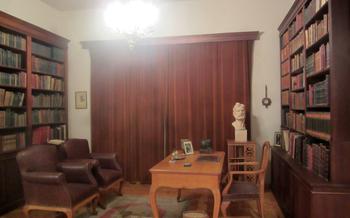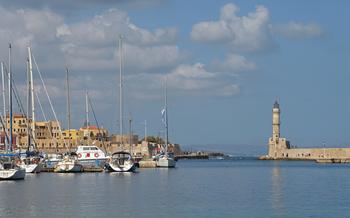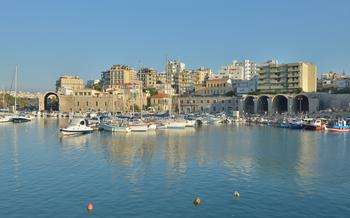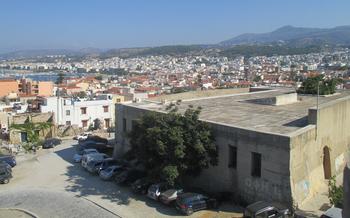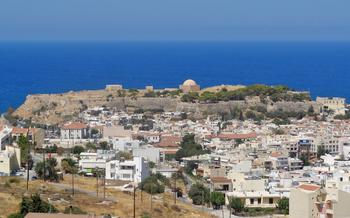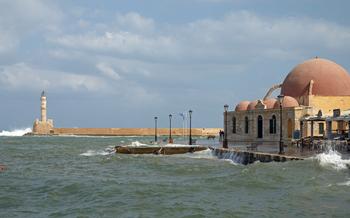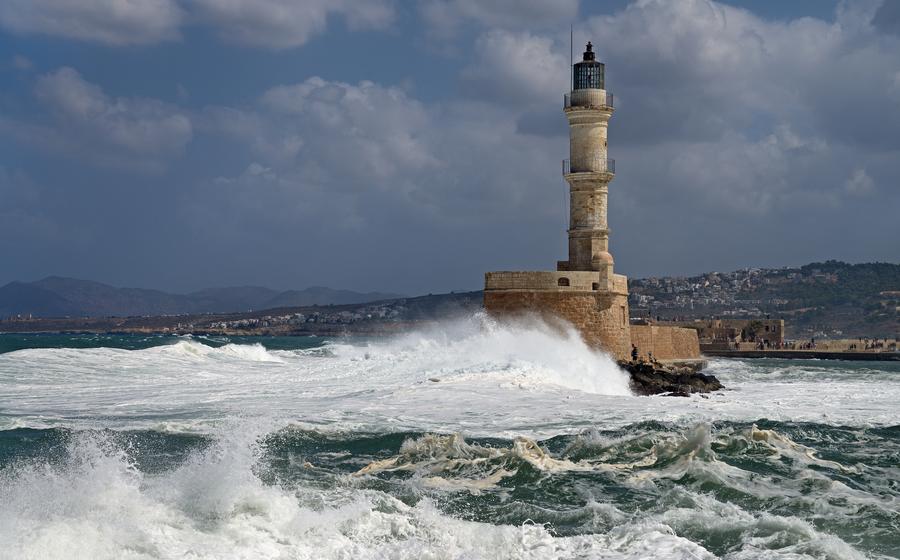
Nautical Museum of Crete
- Nautical Museum of Crete: A Journey Through Maritime Heritage
- A Journey Through Maritime History
- The Minoan Maritime Legacy
- Venetian and Ottoman Influences
- The Battle of Crete: A Pivotal Moment
- The Cretan Navy: Past and Present
- Ship Models and Maritime Art
- Temporary Exhibitions and Events
- Educational Programs and Outreach
- Behind-the-Scenes Tour
- Accessibility and Facilities
- Volunteer Opportunities
- Souvenirs and Merchandise
- Photography and Social Media
- Insider Tip: Hidden Gem of the Museum
Nautical Museum of Crete: A Journey Through Maritime Heritage
A Treasure Trove of Maritime History:
Nestled in the heart of Chania, the Nautical Museum of Crete stands as a testament to the island's rich maritime heritage. Established in 1973, the museum offers a captivating journey through the annals of seafaring in the Mediterranean. Its collection boasts an impressive array of maritime artifacts, model ships, naval uniforms, navigation instruments, and relics from shipwrecks, providing visitors with a comprehensive insight into Crete's maritime past.
Location and Accessibility:
The Nautical Museum is conveniently situated in the Old Venetian Harbor of Chania, a picturesque setting that adds to its allure. The museum is easily accessible on foot from the city center or by public transportation. Visitors can find ample parking spaces in the vicinity, making it a convenient destination for both locals and tourists.
Must-See Exhibits and Artifacts:
Among the must-see exhibits at the Nautical Museum are the Minoan ship models, offering a glimpse into the maritime prowess of this ancient civilization. The museum also houses a collection of Venetian and Ottoman artifacts, reflecting the island's rich multicultural history. Visitors can marvel at the intricate details of the ship models, admire the navigational instruments, and learn about the maritime trade routes that connected Crete to the wider Mediterranean world.
Tips for Planning Your Visit:
To make the most of your visit to the Nautical Museum, it's advisable to plan your trip in advance. Check the museum's website for opening hours and admission fees, which may vary depending on the season. Guided tours are available, providing visitors with a deeper understanding of the exhibits and Crete's maritime history. Additionally, the museum offers educational programs and workshops for families and school groups, making it an ideal destination for learning and exploration.
A Journey Through Maritime History
Journey through the annals of maritime history at the Nautical Museum of Crete. Immerse yourself in the rich collection of maritime artifacts, each telling a tale of Crete's seafaring past. Explore the ancient maritime prowess of the Minoans, witnessing well-preserved shipwrecks and underwater excavations that reveal their mastery of the seas. Learn about the evolution of shipbuilding techniques and navigation, tracing the advancements that shaped naval history. Discover anecdotes about famous seafarers and naval battles, bringing the stories of the sea to life. Prepare to be captivated as you embark on this voyage through maritime history, where every exhibit holds a treasure trove of knowledge and intrigue.
The Minoan Maritime Legacy
The Nautical Museum of Crete houses a wealth of exhibits that showcase the maritime achievements of the Minoan civilization, a powerful and advanced society that flourished on the island from around 2700 to 1450 BC.
Well-Preserved Shipwrecks and Underwater Excavations: One of the highlights of the museum is the collection of well-preserved shipwrecks that have been excavated from the waters around Crete. These vessels offer a fascinating glimpse into the construction techniques and seafaring capabilities of the Minoans. The museum also displays artifacts recovered from underwater excavations, such as pottery, tools, and weapons, which provide further insights into Minoan maritime trade and exploration.
The Role of the Sea in Minoan Trade and Exploration: The Minoans were skilled seafarers who utilized their maritime prowess to establish a vast trading network throughout the Mediterranean and beyond. The museum's exhibits illustrate the importance of the sea to Minoan trade, with displays of imported goods from far-off lands, such as Egypt, Syria, and Anatolia. The museum also highlights the Minoans' exploration of the Mediterranean, as evidenced by the discovery of Minoan artifacts on islands and coastal regions throughout the sea.
Anecdotes about King Minos and His Maritime Prowess: The legendary King Minos, who is often associated with the Minoan civilization, is said to have possessed a powerful navy that dominated the seas. The museum features anecdotes and stories about King Minos's naval expeditions and his role in establishing Minoan maritime supremacy. These tales provide a glimpse into the mythical and historical aspects of Minoan seafaring.
Venetian and Ottoman Influences
Crete's rich maritime history extends beyond the Minoan era, encompassing the periods of Venetian and Ottoman rule. During these times, the island served as a strategic naval base, facilitating trade and commerce across the Mediterranean. The Nautical Museum of Crete sheds light on this fascinating chapter of maritime history through its collection of artifacts and exhibits.
Discover the architectural legacy of the Venetians, who transformed Crete's ports and harbors, constructing impressive fortifications and shipyards. Examine artifacts related to shipbuilding techniques, navigation instruments, and maritime trade during this period. Learn about the role of Crete as a vital link between East and West, facilitating the exchange of goods, ideas, and cultures.
The Ottoman Empire's influence on Crete's maritime heritage is also explored in the museum. Artifacts and documents showcase the naval prowess of the Ottomans, their shipbuilding methods, and their strategies for controlling the sea lanes. Explore exhibits highlighting the impact of Ottoman rule on Crete's maritime economy and trade networks.
Personal accounts from Venetian and Ottoman sailors, merchants, and travelers provide a glimpse into the daily life and challenges of seafaring during these periods. Through their stories, you'll gain a deeper understanding of the cultural interactions and conflicts that shaped Crete's maritime identity.
The Battle of Crete: A Pivotal Moment
The Nautical Museum of Crete dedicates a significant section to the Battle of Crete, a critical event in the island's history during World War II. This meticulously curated exhibition transports visitors back in time to witness the pivotal clash between Allied and German forces that unfolded on the island's shores. Through artifacts, photographs, and interactive displays, the museum vividly portrays the events leading up to the battle, the fierce fighting that ensued, and the aftermath that deeply impacted Crete's destiny.
Heroes and Atrocities: Personal accounts, letters, and diaries from participants bring to life the stories of courage, sacrifice, and resilience that unfolded during the battle. Visitors are introduced to the heroic feats of Cretan civilians and Allied soldiers who fought alongside one another against overwhelming odds. Conversely, the exhibition also sheds light on the atrocities committed by the German occupiers, highlighting the suffering and devastation they inflicted upon the island's population.
Strategic Significance: The Battle of Crete was not just a local conflict; it held immense strategic importance in the broader context of World War II. The museum delves into the reasons why Crete became a crucial target for both sides, exploring the island's strategic location and its potential impact on the course of the war in the Mediterranean. Visitors gain a deeper understanding of the geopolitical factors at play and the consequences of the battle's outcome for the Allied campaign.
Legacy and Remembrance: The exhibition concludes by examining the enduring legacy of the Battle of Crete. It highlights the island's resilience in the face of adversity and its unwavering commitment to preserving the memory of those who fought and sacrificed. Visitors are encouraged to reflect on the lessons learned from this pivotal event and its continued relevance to contemporary issues of war, peace, and the fight against tyranny.
The Cretan Navy: Past and Present
The Nautical Museum of Crete not only delves into the distant past but also sheds light on the rich maritime heritage of Crete in more recent times, particularly focusing on the Cretan Navy.
Exhibits within the museum showcase the history and evolution of the Cretan Navy, from its humble beginnings to its current role as a vital part of Greece's maritime security apparatus. Visitors can learn about the contributions of Cretan sailors throughout history, their bravery during wartime, and their ongoing commitment to protecting Crete's waters.
Personal stories from Cretan naval officers bring the history of the Cretan Navy to life. These accounts offer firsthand insights into the challenges and triumphs of serving in the navy, as well as the deep sense of pride and camaraderie among its members.
Whether you have a personal connection to the Cretan Navy or are simply fascinated by maritime history, this section of the museum provides a unique opportunity to explore the legacy and ongoing importance of Crete's naval forces.
Ship Models and Maritime Art
The Nautical Museum of Crete houses a captivating collection of intricately crafted ship models, each a testament to the skill and artistry of its maker. These models represent various periods of maritime history, from ancient times to the modern era. Visitors can marvel at the meticulous attention to detail, from the rigging to the sails, providing a glimpse into the engineering and design of ships throughout the ages.
In addition to the ship models, the museum showcases a range of maritime-themed artwork, including paintings, sculptures, and engravings. These artworks depict scenes of naval battles, seafaring adventures, and the beauty of the Cretan coastline. They offer visitors a unique perspective on the relationship between art and maritime history, capturing the essence of life on the sea.
The significance of these models and artworks extends beyond their aesthetic value. They serve as valuable historical documents, providing insights into the evolution of shipbuilding techniques, navigation methods, and the cultural significance of the sea in Cretan society. Each model and artwork tells a story, inviting visitors to explore the rich maritime heritage of Crete and the wider Mediterranean region.
One of the most striking ship models on display is a replica of the Minoan ship "Minotaur," which was constructed based on archaeological evidence and historical descriptions. This model offers a glimpse into the advanced shipbuilding techniques of the Minoans, who were among the earliest civilizations to master the art of seafaring.
Among the maritime-themed artworks, visitors can admire a stunning painting depicting the Battle of Crete during World War II. The painting captures the intensity of the battle, with Allied and German ships engaged in a fierce struggle for control of the island. The artist's skillful use of color and composition conveys the drama and chaos of this pivotal moment in Cretan history.
These ship models and maritime artworks are more than just exhibits; they are portals into the past, inviting visitors to embark on a journey of discovery through the rich maritime history of Crete.
Temporary Exhibitions and Events
The Nautical Museum of Crete is not just a static repository of maritime history but also a dynamic venue for temporary exhibitions and special events that keep visitors engaged and informed about the latest developments in the field. These exhibitions and events offer unique perspectives, showcase new research, and feature special collections that complement the museum's permanent displays.
From thought-provoking photography exhibits that capture the essence of maritime life to educational workshops that delve into specific aspects of naval history, the museum's temporary offerings cater to a wide range of interests. Don't miss the opportunity to attend lectures by renowned experts, participate in hands-on activities, or witness live demonstrations of traditional shipbuilding techniques.
To make the most of your visit, check the museum's website or social media channels for upcoming events and plan your trip accordingly. Temporary exhibitions often have limited runs, so seize the chance to experience something truly special during your visit to the Nautical Museum of Crete.
Insider Tip: Keep an eye out for special events and workshops that offer unique insights into specific aspects of maritime history. These events often provide an opportunity to engage with experts, participate in hands-on activities, and gain a deeper understanding of the museum's collection.
Educational Programs and Outreach
The Nautical Museum of Crete recognizes the importance of education in preserving and promoting maritime heritage. To this end, the museum offers a range of educational programs and outreach initiatives tailored to diverse audiences, including school groups, families, and individuals.
For school groups, the museum provides guided tours that align with educational curricula, allowing students to engage with maritime history in a hands-on and interactive manner. These tours are designed to foster a deeper understanding of Crete's maritime legacy and its significance in shaping the island's culture and identity.
Families visiting the museum can participate in interactive workshops and activities designed to spark children's curiosity and imagination. These activities may include storytelling sessions, craft workshops, and treasure hunts, enabling families to learn together and create lasting memories.
The museum also offers lectures, workshops, and seminars for individuals interested in delving deeper into specific aspects of maritime history, archaeology, and conservation. These events feature experts from various fields, providing attendees with unique insights and opportunities for discussion.
One personal account from a participant in the museum's educational programs highlights the impact of these initiatives:
"My son attended a storytelling session at the Nautical Museum, and he was captivated by the tales of ancient seafarers and their adventures. He couldn't stop talking about it for days, and it sparked a newfound interest in maritime history that we continue to explore together." - Maria, a museum visitor
The Nautical Museum of Crete's educational programs and outreach initiatives play a vital role in ensuring that the island's rich maritime heritage is passed on to future generations, fostering a sense of appreciation and understanding for the sea and its profound influence on Cretan history and culture.
Behind-the-Scenes Tour
Embark on an exclusive journey beyond the public galleries by arranging a behind-the-scenes tour of the Nautical Museum of Crete. This unique experience grants you rare access to restricted areas and storage facilities, where the museum's hidden treasures await. Discover the intricate process of artifact conservation and restoration as you witness the dedication and expertise of the museum's skilled staff. Listen to captivating stories from conservators and learn about the challenges they face in preserving Crete's maritime heritage. This insider's perspective offers a deeper understanding of the museum's mission and the tireless efforts to safeguard the treasures of the sea.
Accessibility and Facilities
The Nautical Museum of Crete is committed to providing an inclusive and accessible experience for all visitors. The museum features a range of accessibility features to ensure that everyone can enjoy its exhibits and programs. Wheelchair ramps and elevators provide easy access to all levels of the museum, and accessible restrooms are available throughout. Visitors can also borrow wheelchairs upon request.
In addition to its accessibility features, the museum offers a variety of facilities to enhance the visitor experience. A comfortable café provides a place to relax and enjoy refreshments, while a well-stocked gift shop offers a range of nautical-themed souvenirs and merchandise. For those seeking further knowledge, a comprehensive library and research center is available for use by visitors and researchers alike.
To ensure a smooth and enjoyable visit, the museum provides a range of informative resources. Visitors can purchase guidebooks and maps at the gift shop, or download digital versions from the museum's website. Multilingual audio guides are also available for rent, offering detailed information on the museum's exhibits in a variety of languages.
The Nautical Museum of Crete welcomes visitors of all ages and abilities. With its accessible features, comprehensive facilities, and informative resources, the museum offers a rich and rewarding experience for everyone.
Volunteer Opportunities
The Nautical Museum of Crete offers a range of volunteer opportunities for individuals passionate about maritime history and heritage. By joining the museum's dedicated team of volunteers, you can contribute to preserving and promoting Crete's rich maritime legacy.
As a volunteer, you'll have the chance to assist with various museum tasks, including:
-
Exhibition Support: Assist in setting up and maintaining exhibits, ensuring they are presented in an engaging and informative manner.
-
Educational Programs: Help conduct educational workshops, guided tours, and lectures for school groups, families, and individuals.
-
Research and Archiving: Contribute to the museum's research and archiving efforts by assisting with data entry, cataloging artifacts, and conducting historical research.
-
Visitor Services: Welcome and assist visitors, providing information and guidance to enhance their museum experience.
-
Conservation and Restoration: Get involved in the museum's conservation and restoration efforts, helping to preserve and maintain its valuable artifacts.
Volunteering at the Nautical Museum of Crete is a rewarding experience that offers a unique opportunity to learn, contribute, and be part of a dynamic team. Whether you're a history enthusiast, a maritime buff, or simply someone looking to make a difference, the museum welcomes volunteers of all backgrounds and skill levels.
To learn more about volunteer opportunities and how to apply, visit the museum's website or inquire at the museum's front desk. Join the Nautical Museum of Crete's volunteer team and become a part of preserving and sharing Crete's maritime history with the world.
Souvenirs and Merchandise
The Nautical Museum of Crete houses a well-stocked gift shop where visitors can find a treasure trove of unique souvenirs and nautical-themed merchandise. These items are not just mementos of your visit; they are also a way to support the museum's mission and activities.
From intricately crafted model ships to replicas of ancient artifacts, the gift shop offers a wide range of souvenirs that cater to every taste and budget. You can find handcrafted items made by local artisans, books on maritime history and exploration, and even educational toys for children.
When choosing a souvenir, take your time to browse the collection and find something that truly resonates with you. Whether it's a delicate seashell necklace, a hand-painted ceramic plate depicting a maritime scene, or a vintage-style poster featuring a classic sailing ship, your souvenir should be a cherished reminder of your visit to the museum and your connection to the seafaring heritage of Crete.
The museum staff is always happy to assist you in finding the perfect souvenir. They can share their personal recommendations and provide information about the artisans and craftsmen who create these unique items.
So, as you leave the Nautical Museum of Crete, don't forget to stop by the gift shop and bring home a piece of maritime history to treasure for years to come. Your purchase will not only serve as a reminder of your visit but also contribute to the preservation and promotion of Crete's rich seafaring legacy.
Photography and Social Media
Photography: - Flash photography is not permitted to ensure the preservation of delicate artifacts. - Tripods are allowed but must be used cautiously to avoid obstructing other visitors. - For professional photography or commercial use, special permission is required.
Social Media: - Share your museum experience using the official hashtag #NauticalMuseumCrete. - Follow the museum's social media channels for updates on new exhibits and events. - Tag the museum in your photos and posts for a chance to be featured.
Discover and Share: - Explore the museum's Instagram feed for stunning images and behind-the-scenes glimpses. - Join the museum's Facebook group for discussions, Q&A sessions, and exclusive content. - Tweet your thoughts and impressions using the museum's Twitter handle.
Photography Tips: - Use natural light whenever possible for the most vibrant colors and details. - Experiment with different angles and perspectives to capture unique shots. - Look for reflections and symmetry to add depth and interest to your photos.
Insider Tip: Hidden Gem of the Museum
Amidst the many captivating exhibits at the Nautical Museum of Crete, there lies a hidden gem that often goes unnoticed by visitors. Tucked away in a secluded corner, you'll find a meticulously crafted model of an ancient Minoan ship, believed to be one of the earliest depictions of a seafaring vessel. The model is a testament to the advanced shipbuilding techniques of the Minoans, who were renowned for their maritime prowess.
As you gaze upon this intricate replica, imagine the skilled hands that painstakingly recreated every detail, from the ship's hull to its intricate rigging. Let your mind wander back in time, picturing Minoan sailors embarking on daring voyages across the Mediterranean Sea, their hearts filled with both excitement and trepidation.
Take a moment to appreciate the historical significance of this model and the story it tells. It's a tangible link to a civilization that left an indelible mark on maritime history. Whether you're a seasoned history buff or simply curious about the ancient world, this hidden gem is sure to capture your imagination and leave you with a lasting impression.
